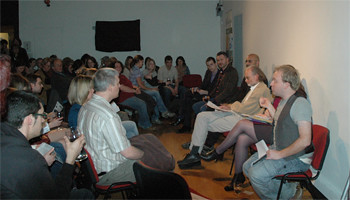Below is a piece kindly written by Professor Andrew Lawrence especially for Cardiff sciSCREEN, and is in reference to the Halloween screening of Human Centipede at Chapter on Friday 29th of October. 'Disgust is a frequent and powerful component of cinematic experience – in particular in horror movies. So frequent, in fact, that a whole film genre capitalizing on disgust has been coined: ‘cinéma vomitif’. But what does it mean to be disgusted and why do we subject ourselves to such an obviously unpleasant experience?
Building on the work of Charles Darwin, the psychologists Paul Rozin, Jonathan Haidt and their colleagues have argued that disgust originated in the rejection response to bad tastes, explaining its characteristic, pan-cultural expression (the nose wrinkle, retraction of the upper lip, and mouth gape), which acts either to discourage entry into the body or to encourage rejection from the body. From such basic origins, however, the function of disgust has somehow shifted. Disgust has evolved into a much more abstract and ideational emotion, such that it can be thought of as ‘the guardian of the temple of the bodily self’. At its most abstract, disgust can be elicited by any evidence that our bodies are really no different from animal bodies. Envelope violations (mutilations, fusions, etc) and death are disgusting because they are uncomfortable reminders of our animal vulnerability (Rozin, Haidt & McCauley, 2008). On this analysis, it becomes clear why certain kinds of fictional monsters are disgusting – often human/animal or living/dead hybrids, where the normal body envelope has been violated or is decaying, destroying human dignity and reminding us of our creatureliness and mortality.
But given that the experience of disgust is so unpleasant, engendering powerful feelings of revulsion and strongly compelling us to reject, why do we subject ourselves to this experience at movies such as the Human Centipede? Perhaps the most compelling answer comes from the philosopher Noël Carroll (1990). According to Carroll, horror fictions engender not just fear and disgust, but also fascination and curiosity, by very virtue of possessing a certain kind of monster, an ‘anomaly’, which blends the boundary between the human and the animal or the living and the dead, violating the temple of the (human) body and the soul itself. The paradoxical linking of repulsion and fascination in disgust has been underscored by numerous theorists, but is still deeply mysterious, and is one reason why disgust is such a fertile ground for emotion research. So, according to Carroll, disgust (at the movies) is the price an audience pays for fascination – enjoying horror on this account is not paradoxical; the enjoyment resides not in our disgust, but in our (morbid) fascination.' Andrew Lawrence is a Professor at the School of Psychology at Cardiff University. At Cardiff they are studying both the psychology and neurobiology of disgust. They are interested in how disgust evolved from a food-rejection system to underpin various forms of aesthetic, social and even moral rejection. They study the neural correlates of ‘basic’ (food-based), aesthetic and ‘socio-moral’ disgust using techniques like functional brain imaging and studies of individuals with various forms of brain damage and psychiatric illness; we study the role that disgust plays in attitudes and prejudice, in particular forms of ‘dehumanization’; and we study how people respond to the disgust of others. Disgust is the ‘body and soul’ emotion and is a rich area in which to explore the nature of our emotional lives. For further details of Andrew’s research, please see: Andrew Lawrence. References and further reading For accounts of disgust in film theory see: Brottman, Mikal. 1997. Offensive films. Toward an anthropology of cinéma vomitif. Wetport, CT. Greenwood Carroll, Noël. 1990. The philosophy of horror. New York: Routledge For a psychological account of disgust see: Rozin, Paul, Haidt Jonathan, McCauley, Clark. (2008). Disgust. In Michael Lewis et al. (editors), Handbook of Emotions, 3rd edition (pp. 757-776). New York: Guilford Press. This chapter, and many other readings on disgust, together with a scale to measure your own ‘disgust sensitivity’ can be found on Jonathan Haidt’s website. The popular science book ‘Descartes’ Baby’ by Paul Bloom (2005) contains an excellent chapter on disgust, detailing Rozin and Haidt’s theory of disgust and its problems. For psychological research on unusual aesthetic emotions, including disgust, see e.g.: Silvia, Paul (2009). Looking past pleasure: anger, confusion, disgust, pride, surprise, and other unusual aesthetic emotions. Psychology of Aesthetics, Creativity, and the Arts 3(1): 48-51. This, and other related works are available on Paul Silvia’s website.








No comments:
Post a Comment